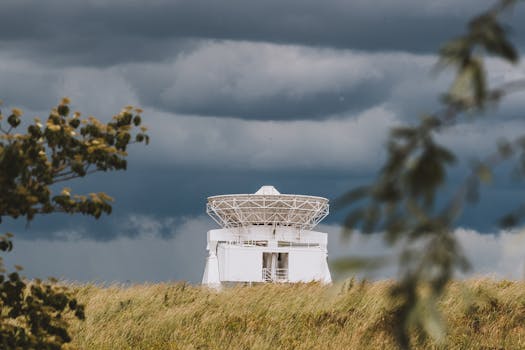GEO Satellites: Understanding the Technology and Applications of Geostationary Orbit Satellites

GEO satellites, or geostationary orbit satellites, are a type of satellite that orbits the Earth at an altitude of approximately 36,000 kilometers above the equator. At this altitude, the satellite’s orbital period is equal to the Earth’s rotational period, which is 24 hours. This means that a GEO satellite appears to be stationary in the sky, relative to an observer on the ground, and can provide continuous coverage of a specific region.
The concept of GEO satellites was first proposed by Arthur C. Clarke in 1945, and the first GEO satellite, Syncom 2, was launched in 1963. Since then, numerous GEO satellites have been launched, and they have become a crucial part of modern telecommunications. GEO satellites are used for a variety of applications, including television broadcasting, telecommunications, and weather forecasting.
One of the primary advantages of GEO satellites is their ability to provide continuous coverage of a specific region. This makes them ideal for applications such as television broadcasting, where a signal needs to be transmitted to a wide audience over a large area. GEO satellites are also used for telecommunications, providing internet and phone services to remote or underserved areas. In addition, GEO satellites are used for weather forecasting, providing images of cloud patterns and storm systems that help meteorologists predict the weather.
GEO satellites have also been used for a variety of other applications, including navigation, Earth observation, and space exploration. For example, the Global Positioning System (GPS) relies on a network of GEO satellites to provide location information to users around the world. GEO satellites have also been used to study the Earth’s climate, oceans, and land surfaces, and have played a critical role in our understanding of the Earth’s systems.
In recent years, there has been a growing trend towards the use of High-Throughput Satellites (HTS) in GEO orbit. HTS satellites are designed to provide high-speed internet services to a large number of users, and have the potential to revolutionize the way we access the internet. Several companies, including Intelsat and SES, have launched HTS satellites in GEO orbit, and the technology is expected to play a major role in the development of 5G networks.
However, GEO satellites also have some limitations. One of the primary challenges facing GEO satellites is the risk of interference from other satellites and terrestrial systems. This can cause problems with signal quality and availability, and can be particularly problematic for applications that require high levels of reliability, such as telecommunications. Additionally, GEO satellites are subject to the effects of space weather, including solar flares and coronal mass ejections, which can cause problems with satellite operations.
Despite these challenges, GEO satellites remain a crucial part of modern telecommunications, and will continue to play a significant role in the development of new technologies and applications. As the demand for high-speed internet and other satellite-based services continues to grow, the importance of GEO satellites will only continue to increase.
Applications of GEO Satellites
GEO satellites have a wide range of applications, including television broadcasting, telecommunications, weather forecasting, navigation, Earth observation, and space exploration. Television broadcasting is one of the most common applications of GEO satellites, and is used to transmit signals to a wide audience over a large area. GEO satellites are also used for telecommunications, providing internet and phone services to remote or underserved areas.
Weather forecasting is another critical application of GEO satellites. By providing images of cloud patterns and storm systems, GEO satellites help meteorologists predict the weather and issue warnings for severe weather events. Navigation is also an important application of GEO satellites, with the Global Positioning System (GPS) relying on a network of GEO satellites to provide location information to users around the world.
Earth observation is another significant application of GEO satellites, with satellites used to study the Earth’s climate, oceans, and land surfaces. This information is critical for our understanding of the Earth’s systems and for predicting future changes to the environment. Finally, GEO satellites have played a critical role in space exploration, providing communications and navigation services for spacecraft and astronauts.
Conclusion
In conclusion, GEO satellites are a crucial part of modern telecommunications, and have a wide range of applications, including television broadcasting, telecommunications, weather forecasting, navigation, Earth observation, and space exploration. While they have some limitations, including the risk of interference and the effects of space weather, GEO satellites will continue to play a significant role in the development of new technologies and applications. As the demand for high-speed internet and other satellite-based services continues to grow, the importance of GEO satellites will only continue to increase.
GEO satellites, or geostationary orbit satellites, are a type of satellite that orbits the Earth at an altitude of approximately 36,000 kilometers above the equator. At this altitude, the satellite’s orbital period is equal to the Earth’s rotational period, which is 24 hours. This means that a GEO satellite appears to be stationary in the sky, relative to an observer on the ground, and can provide continuous coverage of a specific region.
The technology of GEO satellites has been continuously evolving, with new advancements being made in recent years. The use of HTS satellites in GEO orbit is one example of this, with several companies launching HTS satellites in recent years. The development of new satellite technologies, such as quantum satellites and satellite constellations, is also expected to play a major role in the future of GEO satellites.
Overall, GEO satellites are a critical component of modern telecommunications, and will continue to play a significant role in the development of new technologies and applications. Their ability to provide continuous coverage of a specific region, combined with their high altitude and long orbital period, make them ideal for a wide range of applications, and their importance will only continue to grow in the coming years.






